Personality and sound: a telephoto microphone by Antonio Meucci and the irony of historical justice
I suppose that many people know that the invention of electrical transmission of sound over a distance does not belong to the “hero” of the old school textbooks in physics, Alexander Bell. I understand some accordion of the topic (especially for a certain audience), but I cannot pass by the unjustly forgotten Antonio Meucci, his interesting and in many ways tragic fate of the innovator.
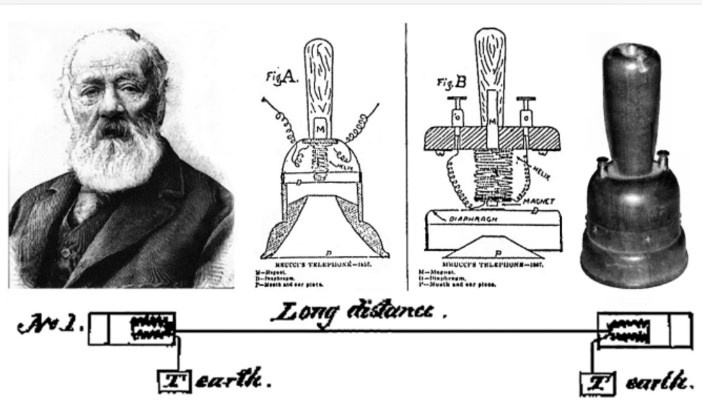
I will try to explain some versions of the invention of telephony, as well as describe the characteristics of the person, the biography of the inventor and the time in which he lived. All this will help answer the question why for so long the fame of the author of a revolutionary device belonged to another person. The biography of the inventor is saturated with a mass of bright events and can become the basis for an exciting novel.
For those who do not know, let me tell you that it is Meucci who is the author of the device, without which most of us can no longer imagine our full existence and the very principle on which electrical transmission of sound is carried out over a distance.
In many ways, my desire to write this post is due to the fact that in numerous publications about Meucci there is a certain confusion with the dates and facts of his biography.
Antonio Meucci was born in San Frediano, in the suburbs of Florence, which at that time was part of the Grand Duchy of Tuscany, on April 13, 1808. He became the firstborn in the family of police officer Amatis Meucci and housewives Dominica Pepi. The Meucci family lived at 44, Via dei Serragli, at that time not a very prestigious area in Florence. According to church and administrative records of the Meucci family, it is known that there were nine children in it, only four of whom survived to adulthood. From this information it can be concluded that the inventor's family was not rich at all.
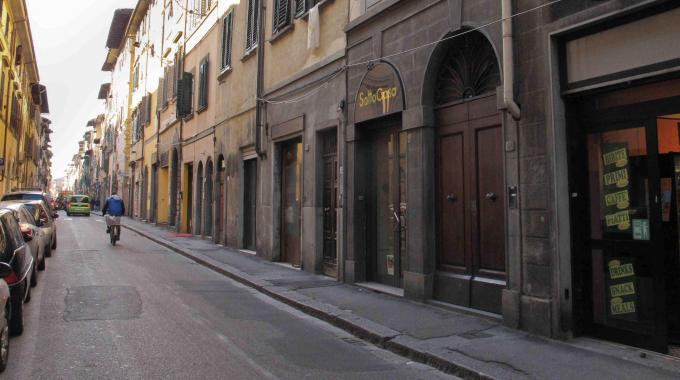
Via dei Serragli, our days
Little is known about the early childhood of a scientist. However, biographers Meucci note that little Antonio was very impressed by his great countrymen, especially Leonardo Da Vinci. In adolescence, Meucci with interest engaged in simple physical experiments, was often busy trying to improve some mechanisms and objects at home, which sometimes irritated his father. In addition, the future inventor showed interest in such areas of knowledge as physics, chemistry and medicine.
About getting the inventor of secondary education is not aware of anything, except that Meucci studied in Florence. It is also known that at the age of fifteen, in November 1821, young Meucci was enrolled in the Florence Academy of Fine Arts, where he studied chemistry and mechanics. Due to financial problems, at the age of 17 he has to leave the walls of the alma mater and look for work. Capable and assiduous Meucci easily arranged by the customs clerk in one of the departments of the Florentine city government.
The income from a comparatively bread customs post allows the future scientist to continue his studies in 1824. In 1828, having already completed his studies at the academy, Meucci began working in the Florentine Teatro della Pergola as an assistant to one of the famous stage artists Artemio Canovetti. At that time, Meucci was responsible for creating a variety of mechanisms for managing stage equipment and decorations.
Contemporaries in Florence Meucci was remembered by a somewhat eccentric and eccentric man, but at the same time with a very lively mind. Already while working at the Teatro della Pergola, Antonio begins to experiment in the field of acoustics and creates a communication system between the stage and the theater souffleroir post.
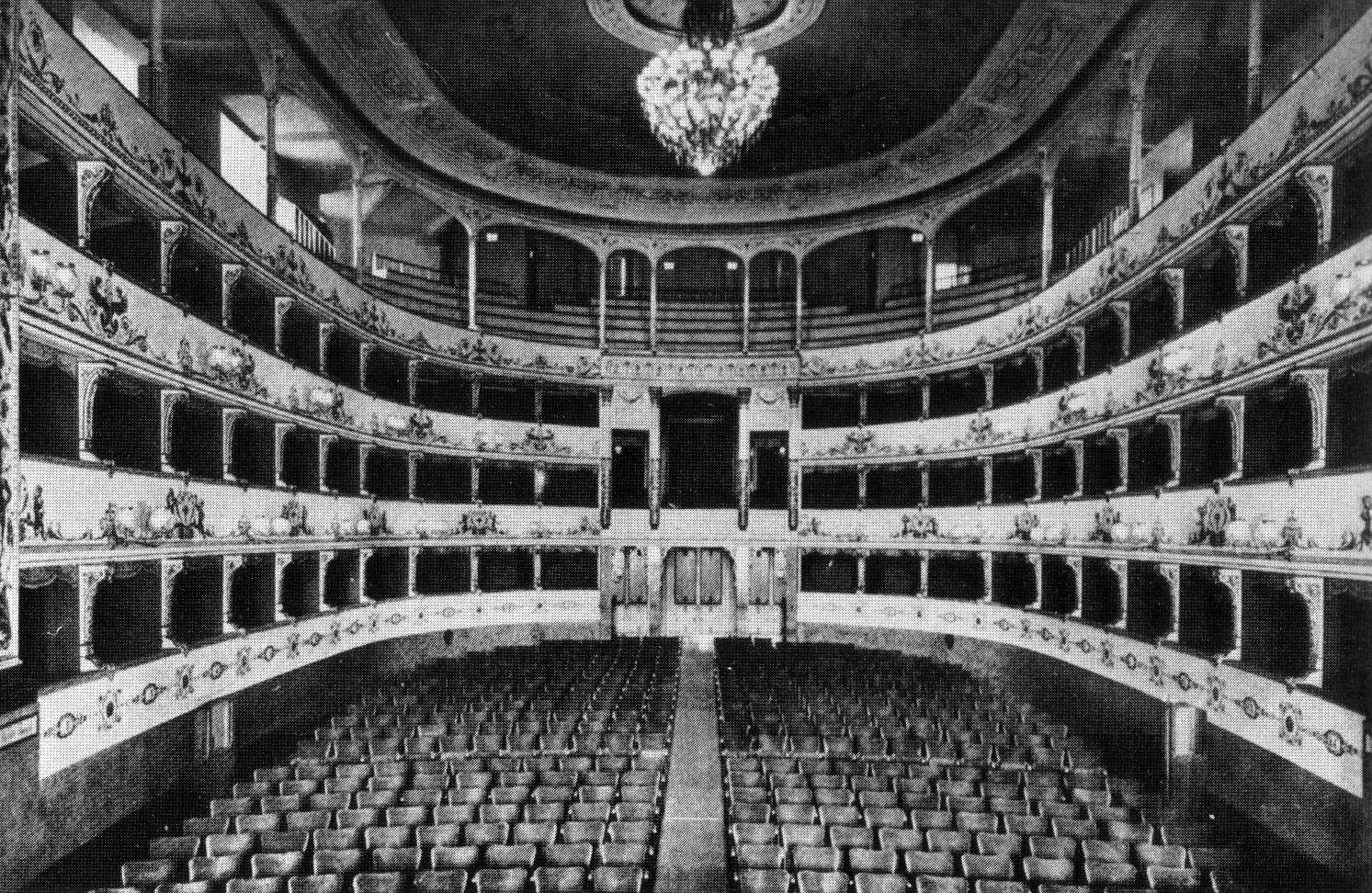
Teatro della Pergola, end of 19th, beginning of 20th century
The main element of the steel construction of the pipe, the connection worked like pipe phones, which were used to a limited extent in the 18th and 19th centuries in mines and on ships.
In 1834, Antonio married the costume designer Teatro della Pergola, Esterr Mchi. According to one of legends, the illness of the wife will become a stimulus for his invention. The relationship of the spouses Meucci biographers describe as almost perfect. The girlfriend of the harsh days of the inventor suffered with her husband all the hardships and deprivation, often supporting his risky initiatives.
Interesting and political views of Antonio Meucci. According to some sources, the inventor was part of the Risorgimento movement, was friends with the legendary Garibaldi and other figures of Young Italy (an extremist organization banned in Austria until 1870). It is with the political activities of Meucci that his emigration to Cuba was connected in 1835. Interestingly, Garibaldi himself left for Latin America in the same year, after the failure of the uprising in Genoa.
Cuba, which was a Spanish colony at the time, was warmly received by Antonio. Meucci was already relatively famous as a talented engineer. Interestingly, he easily managed to get a job in one of the largest theaters that existed at the time in America - “Teatro de Tacone” (today - Gran Teatro de La Habana). The erection of the building of the theater at the time was just completed. The fact is that the governor and captain-general of the island of Cuba, Miguel Tacon, perfectly understood people and made equally unconventional and effective personnel decisions. He immediately realized that in the theater, run by a former pirate, smuggler and slave trader Francisco Marty-i-Torrens, it was Garibaldi’s runaway counterpart Antonio Meucci who could become an ideal engineer.
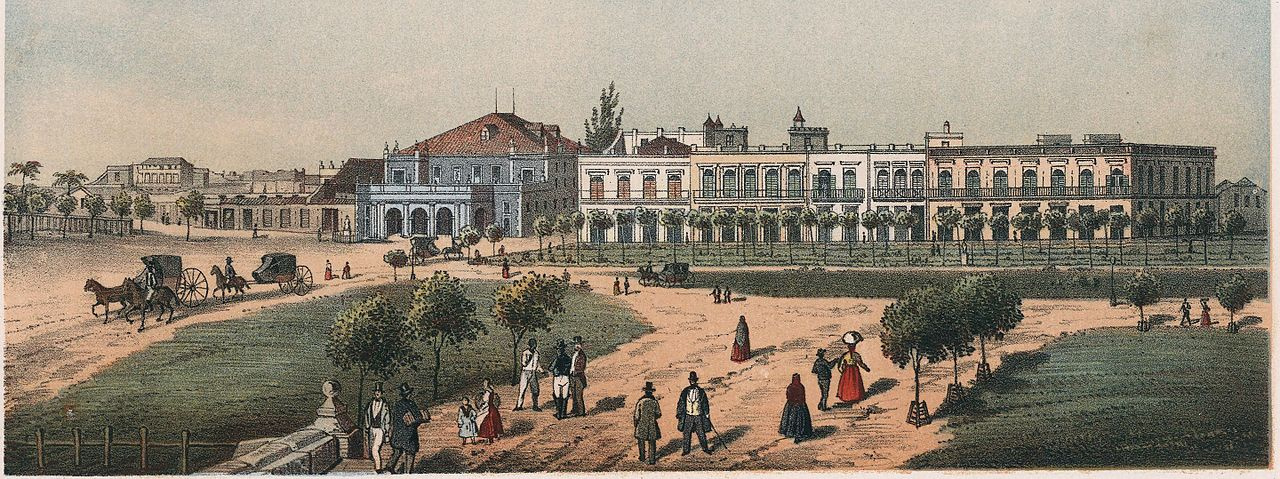
Teatro de Tacone 1855 sample, after the reconstruction of Meucci
By the time of the official opening of Teatro Tacone in 1838, Meucci took part in the creation of all stage mechanisms. Later in 1847, he was to rebuild the theater building affected by the hurricane, changing the roof structure and ventilation to prevent serious damage during natural disasters. In 1840, by the order of Tacon, the inventor designed and built a chemical water purification system for Havana. In 1844, the first electroplating plant in North and South America will be built under the leadership of Meucci.
The work of a theater engineer, well known to the inventor, lasted until 1848, and perhaps, if the governor of Cuba extended the contract with the scientist for another 10 years, we would know another inventor of the telephone. But the contract was extended for only 1 year.
Here you need to make a digression and talk about some of the personal qualities of Meucci. Historians of science describe him as a man of talent and success in many areas, except for one - money. Antonio was a man completely inclined to hoarding, and with sufficient enterprise, he was not very good at protecting his financial interests.
He was tired of the bureaucracy associated with finances, and besides, he hardly perceived the idea of turning inventions into his own business, preferring to simply fulfill orders or invent something “out of love for art”. Much later, he will understand the profitability of an innovative business and its prospects, but will not have sufficient experience in creating profitable enterprises.
After completing work in the theater, Meucci begins to look for an opportunity to earn. His familiar doctor, understanding the needs of the engineer, invites him to create a device that allows the treatment of rheumatism using the magnetic method of Franz Anton Mesmer. For the year, Meucci designs the apatata, which includes a generator, electromagnets, batteries and contact plates, through which the current influences the patient. Meucci modifies the system using a pulsed effect of current and electromagnetic field.
Medical practice Meucci in Havana was commercially successful and did not last much more than a year. Then the fun began. According to one of the versions in 1849, having connected the contacts of the device to the patient, Antonio went into the next room where the generator was and turned on the device, after which he heard the patient's voice coming from the device. According to another version, Meucci began developing electrical sound transmission in Italy, and in the process of working on medical equipment he realized the need to use resonant membranes.

A number of biographers believe that during the Cuban period, Meucci did not even have a hint of a prototype device, and the first working versions of the telephoto microphone appeared in the United States when the inventor’s wife fell ill and he needed a device for permanent home communication.
Research is time-consuming, and there is almost no time left for medical practice. In 1850, the last contract with the governor of Havana expires. Cuban authorities are beginning to see the threat in an eccentric revolutionary, forcing Meucci to emigrate again, this time to the United States. The country to which Meucci is going was not chosen by chance. The inventor was impressed with the success of Samuel Morse and decided that he could earn his own money with the help of inventions.
Meucci and his wife arrived in the United States in 1850. I want to emphasize that Antonio was not at all a beggar Italian raghead, but arrived in the US with a fairly decent amount of 26,000 pesos ($ 500,000 in modern terms). The money earned in Havana allowed him not only to live relatively comfortably, but also to invest in industrial enterprises and support his comrades in the fight.
In fact, Meucci was one of the American wallets who suffered in the New World from the national liberation movement in Italy (“Young Italy” is an extremist organization, banned in Austria until 1870). In particular, it is known that his long-time friend and national hero of Italy - General Giuseppe Garibaldi, as well as Colonel Paolo Kampedzhi lived for some time in his New York home, located in the Clifton area on Staten Island.
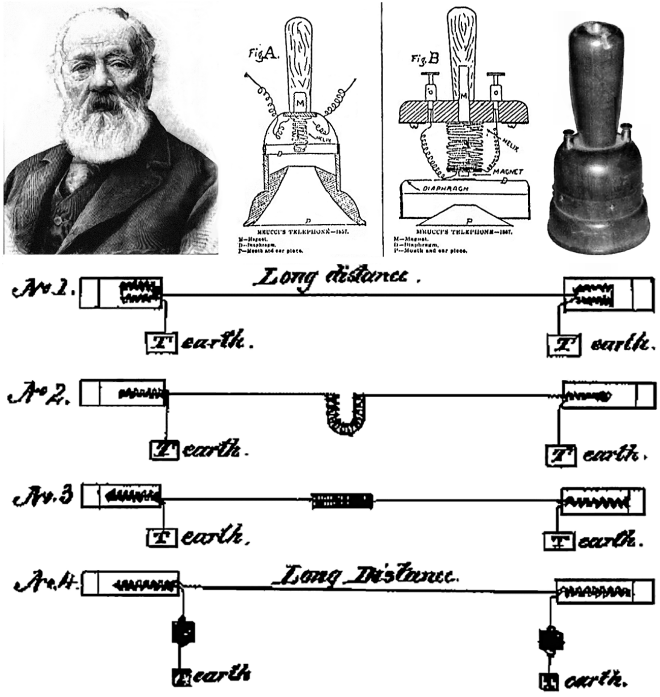
Having invested money in the creation of production, and more specifically in America’s first stearin candle factory, Meucci continues to experiment with a telephoto microphone and achieves impressive results. It is known that a working prototype telephoto microphone was installed in his house to communicate with his wife. A number of notes by Meucci of that period testify to the significant progress of the inventor. They describe the basic principle of electromagnetic sound transmission, known to us today:
From 1856 to 1870, Antonio developed more than 30 different models of tectrons based on the first prototype.
By 1860, the Meucci candle factory became bankrupt, which significantly slowed the inventor’s plans for mass production of the device. The transition to paraffin candles invented by Meucci, and a short sad experience in the brewing business did not yield the expected results. The scientist began to look for investors in Italy, as those Meucci considered wealthy compatriots. But the war started by Garibaldi, who returned from America, was not the best time for such investments. So everyone whom the engineer turned to was refused. It was then that Meucci published a note in the Italian-speaking New York newspaper L'Eco d'Italia, where he described his device and its capabilities in the hope of financial contributions to the project.
Presumably in 1860-1861, after reading a note in L'Eco d'Italia, one of the employees of the company Western Union turned to Meucci with a proposal to sell the invention and the drawings. Meucci, anticipating the investment of development, agrees, having received an oral promise to continue cooperation. For 10 years, Meucci was fed with breakfast until the thought of registering a patent in 1870 did not attend. It was in August of 1870 that Meucci received a transmission of a clear human voice at a distance of a mile, using copper wire insulated with cotton and metal diaphragms of a microphone and radiator as a conductor.
By 1871, Antonio is collecting a package of documents sufficient for a patent application and submitting it using the postal services of Western Union. Due to unknown circumstances, the application disappears, and in December 1871, Meucci was forced to re-collect documentation and submit a so-called. "Patent warning" (the purpose of such a document is to prevent the issuance of a competing patent for the same invention to a subsequent inventor when it is not possible to patent the device). December 28, 1871 this document was registered under the number 3335 and is entitled "Sound Telegraph". However, in 1875, for an unexplained reason, Meucci refuses to extend the patent warning.

1965 Italian postage stamp with portraits by Meucci and Marconi
Despite the efforts made by Meucci, in 1876, inventor Alexander Bell, who developed his device with the support of Western Union, received a patent for the first telephone. Thus, Bell goes down in history as a telephony pioneer and inventor of a device that will be considered for more than 130 years. In 1880, Meucci sued Bella and Western Union, in an attempt to achieve justice, but lost in litigation for financial reasons. For some unknown reason, even the number L'Eco d'Italia disappears from the libraries with Meucci's publication “Sound running through wires”.
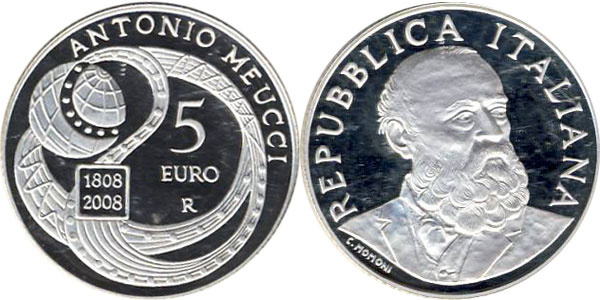
Justice triumphs late. Only on July 11, 2002, the United States Congress passed Resolution No. 269, in which Antonio Meucci was recognized as the true inventor of the telephone. The priority of Meucci in the invention of the phone rejects the Parliament of Canada. In contrast to the resolution of the US Congress, a resolution of the Parliament of Canada was issued, in which Bell is still recognized as the inventor.
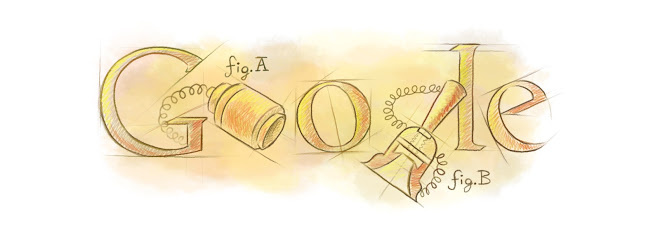
Jubilee Google logo in honor of the birthday of Meucci
Despite the defeat in the trial, Meucci did not lose his presence of mind. From 1870 to 1883, Antonio continued his research in various fields and even registered 4 patents. In total, the inventor has 14 patented inventions (not counting the “telephoto microphone”), ranging from the shape of a stearin candle and ending with a hygrometer.
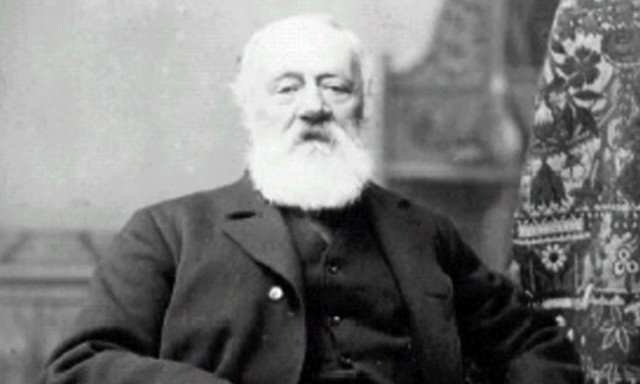
The phone's inventor, scientist and engineer died in 1889. According to the testimony of some biographers, the financial condition of Antonio Meucci in the last years of his life left much to be desired. In addition to the tele-microphone, more than 100 original, innovative ideas of the time, ideas, concepts and developments in such fields as industrial chemistry and chemical production, acoustics, building engineering, mechanics, physiotherapy, pharmacology, domestic lighting, and electricity physics are becoming the heritage of the inventor.

I will try to explain some versions of the invention of telephony, as well as describe the characteristics of the person, the biography of the inventor and the time in which he lived. All this will help answer the question why for so long the fame of the author of a revolutionary device belonged to another person. The biography of the inventor is saturated with a mass of bright events and can become the basis for an exciting novel.
For those who do not know, let me tell you that it is Meucci who is the author of the device, without which most of us can no longer imagine our full existence and the very principle on which electrical transmission of sound is carried out over a distance.
In many ways, my desire to write this post is due to the fact that in numerous publications about Meucci there is a certain confusion with the dates and facts of his biography.
Talented firstborn florentine cop
Antonio Meucci was born in San Frediano, in the suburbs of Florence, which at that time was part of the Grand Duchy of Tuscany, on April 13, 1808. He became the firstborn in the family of police officer Amatis Meucci and housewives Dominica Pepi. The Meucci family lived at 44, Via dei Serragli, at that time not a very prestigious area in Florence. According to church and administrative records of the Meucci family, it is known that there were nine children in it, only four of whom survived to adulthood. From this information it can be concluded that the inventor's family was not rich at all.

Via dei Serragli, our days
Little is known about the early childhood of a scientist. However, biographers Meucci note that little Antonio was very impressed by his great countrymen, especially Leonardo Da Vinci. In adolescence, Meucci with interest engaged in simple physical experiments, was often busy trying to improve some mechanisms and objects at home, which sometimes irritated his father. In addition, the future inventor showed interest in such areas of knowledge as physics, chemistry and medicine.
About getting the inventor of secondary education is not aware of anything, except that Meucci studied in Florence. It is also known that at the age of fifteen, in November 1821, young Meucci was enrolled in the Florence Academy of Fine Arts, where he studied chemistry and mechanics. Due to financial problems, at the age of 17 he has to leave the walls of the alma mater and look for work. Capable and assiduous Meucci easily arranged by the customs clerk in one of the departments of the Florentine city government.
The income from a comparatively bread customs post allows the future scientist to continue his studies in 1824. In 1828, having already completed his studies at the academy, Meucci began working in the Florentine Teatro della Pergola as an assistant to one of the famous stage artists Artemio Canovetti. At that time, Meucci was responsible for creating a variety of mechanisms for managing stage equipment and decorations.
Theatrical inventor and revolutionary
Contemporaries in Florence Meucci was remembered by a somewhat eccentric and eccentric man, but at the same time with a very lively mind. Already while working at the Teatro della Pergola, Antonio begins to experiment in the field of acoustics and creates a communication system between the stage and the theater souffleroir post.

Teatro della Pergola, end of 19th, beginning of 20th century
The main element of the steel construction of the pipe, the connection worked like pipe phones, which were used to a limited extent in the 18th and 19th centuries in mines and on ships.
In 1834, Antonio married the costume designer Teatro della Pergola, Esterr Mchi. According to one of legends, the illness of the wife will become a stimulus for his invention. The relationship of the spouses Meucci biographers describe as almost perfect. The girlfriend of the harsh days of the inventor suffered with her husband all the hardships and deprivation, often supporting his risky initiatives.
Interesting and political views of Antonio Meucci. According to some sources, the inventor was part of the Risorgimento movement, was friends with the legendary Garibaldi and other figures of Young Italy (an extremist organization banned in Austria until 1870). It is with the political activities of Meucci that his emigration to Cuba was connected in 1835. Interestingly, Garibaldi himself left for Latin America in the same year, after the failure of the uprising in Genoa.
Cuba libre
Cuba, which was a Spanish colony at the time, was warmly received by Antonio. Meucci was already relatively famous as a talented engineer. Interestingly, he easily managed to get a job in one of the largest theaters that existed at the time in America - “Teatro de Tacone” (today - Gran Teatro de La Habana). The erection of the building of the theater at the time was just completed. The fact is that the governor and captain-general of the island of Cuba, Miguel Tacon, perfectly understood people and made equally unconventional and effective personnel decisions. He immediately realized that in the theater, run by a former pirate, smuggler and slave trader Francisco Marty-i-Torrens, it was Garibaldi’s runaway counterpart Antonio Meucci who could become an ideal engineer.

Teatro de Tacone 1855 sample, after the reconstruction of Meucci
By the time of the official opening of Teatro Tacone in 1838, Meucci took part in the creation of all stage mechanisms. Later in 1847, he was to rebuild the theater building affected by the hurricane, changing the roof structure and ventilation to prevent serious damage during natural disasters. In 1840, by the order of Tacon, the inventor designed and built a chemical water purification system for Havana. In 1844, the first electroplating plant in North and South America will be built under the leadership of Meucci.
The work of a theater engineer, well known to the inventor, lasted until 1848, and perhaps, if the governor of Cuba extended the contract with the scientist for another 10 years, we would know another inventor of the telephone. But the contract was extended for only 1 year.
Here you need to make a digression and talk about some of the personal qualities of Meucci. Historians of science describe him as a man of talent and success in many areas, except for one - money. Antonio was a man completely inclined to hoarding, and with sufficient enterprise, he was not very good at protecting his financial interests.
He was tired of the bureaucracy associated with finances, and besides, he hardly perceived the idea of turning inventions into his own business, preferring to simply fulfill orders or invent something “out of love for art”. Much later, he will understand the profitability of an innovative business and its prospects, but will not have sufficient experience in creating profitable enterprises.
From rheumatism electrotherapy to the first telephone
After completing work in the theater, Meucci begins to look for an opportunity to earn. His familiar doctor, understanding the needs of the engineer, invites him to create a device that allows the treatment of rheumatism using the magnetic method of Franz Anton Mesmer. For the year, Meucci designs the apatata, which includes a generator, electromagnets, batteries and contact plates, through which the current influences the patient. Meucci modifies the system using a pulsed effect of current and electromagnetic field.
Medical practice Meucci in Havana was commercially successful and did not last much more than a year. Then the fun began. According to one of the versions in 1849, having connected the contacts of the device to the patient, Antonio went into the next room where the generator was and turned on the device, after which he heard the patient's voice coming from the device. According to another version, Meucci began developing electrical sound transmission in Italy, and in the process of working on medical equipment he realized the need to use resonant membranes.

A number of biographers believe that during the Cuban period, Meucci did not even have a hint of a prototype device, and the first working versions of the telephoto microphone appeared in the United States when the inventor’s wife fell ill and he needed a device for permanent home communication.
Research is time-consuming, and there is almost no time left for medical practice. In 1850, the last contract with the governor of Havana expires. Cuban authorities are beginning to see the threat in an eccentric revolutionary, forcing Meucci to emigrate again, this time to the United States. The country to which Meucci is going was not chosen by chance. The inventor was impressed with the success of Samuel Morse and decided that he could earn his own money with the help of inventions.
Collapse of the American Dream
Meucci and his wife arrived in the United States in 1850. I want to emphasize that Antonio was not at all a beggar Italian raghead, but arrived in the US with a fairly decent amount of 26,000 pesos ($ 500,000 in modern terms). The money earned in Havana allowed him not only to live relatively comfortably, but also to invest in industrial enterprises and support his comrades in the fight.
Many authors describe the emigration of Meucci as an escape from Cuba of a poor, poor, loser who sold his equipment and drawings to the first person in the port for $ 6, since he could not pay for the treatment of burns caused by the explosion of the steam boiler. In the same sources it is mentioned that the wife of Meucci allegedly died in Havana, which is also not true.
In fact, Meucci was one of the American wallets who suffered in the New World from the national liberation movement in Italy (“Young Italy” is an extremist organization, banned in Austria until 1870). In particular, it is known that his long-time friend and national hero of Italy - General Giuseppe Garibaldi, as well as Colonel Paolo Kampedzhi lived for some time in his New York home, located in the Clifton area on Staten Island.

Having invested money in the creation of production, and more specifically in America’s first stearin candle factory, Meucci continues to experiment with a telephoto microphone and achieves impressive results. It is known that a working prototype telephoto microphone was installed in his house to communicate with his wife. A number of notes by Meucci of that period testify to the significant progress of the inventor. They describe the basic principle of electromagnetic sound transmission, known to us today:
“It consists of a vibrating diaphragm and an electromagnet with a spiral coil wound around it. Oscillation of the diaphragm changes the magnet current. These current changes are transmitted to the other end of the wire and create a similar vibration of the diaphragm on the receiving device. From notes by Antonio Meucci »
From 1856 to 1870, Antonio developed more than 30 different models of tectrons based on the first prototype.
By 1860, the Meucci candle factory became bankrupt, which significantly slowed the inventor’s plans for mass production of the device. The transition to paraffin candles invented by Meucci, and a short sad experience in the brewing business did not yield the expected results. The scientist began to look for investors in Italy, as those Meucci considered wealthy compatriots. But the war started by Garibaldi, who returned from America, was not the best time for such investments. So everyone whom the engineer turned to was refused. It was then that Meucci published a note in the Italian-speaking New York newspaper L'Eco d'Italia, where he described his device and its capabilities in the hope of financial contributions to the project.
Patent dispute
Presumably in 1860-1861, after reading a note in L'Eco d'Italia, one of the employees of the company Western Union turned to Meucci with a proposal to sell the invention and the drawings. Meucci, anticipating the investment of development, agrees, having received an oral promise to continue cooperation. For 10 years, Meucci was fed with breakfast until the thought of registering a patent in 1870 did not attend. It was in August of 1870 that Meucci received a transmission of a clear human voice at a distance of a mile, using copper wire insulated with cotton and metal diaphragms of a microphone and radiator as a conductor.
By 1871, Antonio is collecting a package of documents sufficient for a patent application and submitting it using the postal services of Western Union. Due to unknown circumstances, the application disappears, and in December 1871, Meucci was forced to re-collect documentation and submit a so-called. "Patent warning" (the purpose of such a document is to prevent the issuance of a competing patent for the same invention to a subsequent inventor when it is not possible to patent the device). December 28, 1871 this document was registered under the number 3335 and is entitled "Sound Telegraph". However, in 1875, for an unexplained reason, Meucci refuses to extend the patent warning.

1965 Italian postage stamp with portraits by Meucci and Marconi
Despite the efforts made by Meucci, in 1876, inventor Alexander Bell, who developed his device with the support of Western Union, received a patent for the first telephone. Thus, Bell goes down in history as a telephony pioneer and inventor of a device that will be considered for more than 130 years. In 1880, Meucci sued Bella and Western Union, in an attempt to achieve justice, but lost in litigation for financial reasons. For some unknown reason, even the number L'Eco d'Italia disappears from the libraries with Meucci's publication “Sound running through wires”.

Commemorative coin, worth 5 Euro, to the 200th anniversary of the inventor
Justice triumphs late. Only on July 11, 2002, the United States Congress passed Resolution No. 269, in which Antonio Meucci was recognized as the true inventor of the telephone. The priority of Meucci in the invention of the phone rejects the Parliament of Canada. In contrast to the resolution of the US Congress, a resolution of the Parliament of Canada was issued, in which Bell is still recognized as the inventor.

Jubilee Google logo in honor of the birthday of Meucci
After the failure of the telephoto startup
Despite the defeat in the trial, Meucci did not lose his presence of mind. From 1870 to 1883, Antonio continued his research in various fields and even registered 4 patents. In total, the inventor has 14 patented inventions (not counting the “telephoto microphone”), ranging from the shape of a stearin candle and ending with a hygrometer.

The phone's inventor, scientist and engineer died in 1889. According to the testimony of some biographers, the financial condition of Antonio Meucci in the last years of his life left much to be desired. In addition to the tele-microphone, more than 100 original, innovative ideas of the time, ideas, concepts and developments in such fields as industrial chemistry and chemical production, acoustics, building engineering, mechanics, physiotherapy, pharmacology, domestic lighting, and electricity physics are becoming the heritage of the inventor.
All Articles